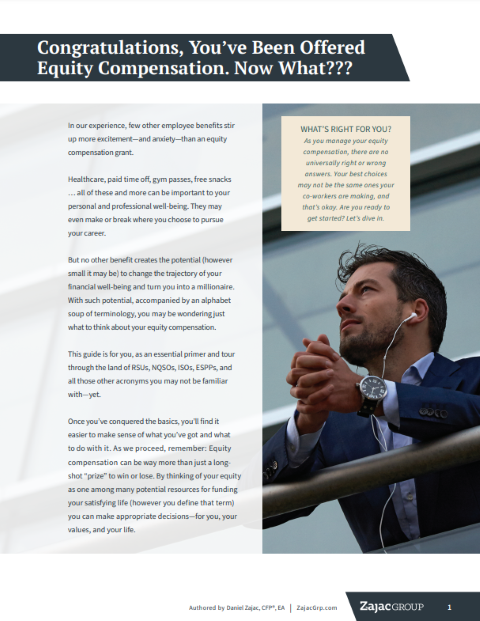If you have employee stock options, you need to determine what kind you have so you know if a cash or cashless exercise makes sense: incentive stock options (ISO) or non-qualified stock options (NQSO).
The differences go far beyond their names. ISOs may provide tax advantages for you, assuming you meet certain requirements. For this reason, many prefer incentive stock options over NQSOs.
But with the tax advantages come increased complications. The rules around qualifying vs. disqualifying dispositions and the alternative minimum tax can make creating a strategy for your ISOs challenging to do.
What can help is understanding the ins and outs of these rules, how your cash flow may be impacted depending on what you choose to do, as well as tactics you can implement to make the most of your options while minimizing risk and making tax-smart decisions.
If you are looking for a solution that allows you to exercise and hold as many shares as possible and limit the cash call required, an AMT balancing strategy might be the best option for you.
How A Qualifying Dispositions of ISOs Works (and Where Alternative Minimum Tax Matters)
First, you need to understand what counts as a qualifying disposition. This occurs when you sell your ISO shares at least 1 year past the exercise date and 2 years past the date the shares were granted.
FREE GUIDE
The Ultimate Guide to Incentive Stock Options
Learn the ins and outs of incentive stock options so you gain a better understanding of what you have.
Selling incentive stock options this way allows you to pay long-term capital tax rates on any realized gains from the exercise price of the options to the final sale price. But while paying a lower tax rate may sound attractive, exercising and holding your ISOs for at least 1-year post-exercise may pose a potential cash-flow problem (as well as considerable investment risk).
You need to consider how you’ll pay the tax due on the exercise and hold of your options, and you’ll also need to figure out how to pay for the exercise price of the stock shares.
The tax that may be due if you exercise and hold incentive stock options is the alternative minimum tax, or AMT. The larger the spread between the exercise price of the ISO and the fair market value of the stock at exercise, the larger the potential for AMT.
It’s not uncommon for that spread to be so large that the subsequent tax bill exceeds the amount of cash you have on hand (or at least, requires a cash call much larger than the amount of cash you’d want to send off to the IRS).
One way to manage this potential cash flow problem is to plan an exercise, hold, and sell strategy that focuses on cash flow first. Doing so gives you a way to use AMT balancing when you exercise your ISOs.
The Potential Cash Flow Problem of an Incentive Stock Options Exercise
When you exercise and hold incentive stock options, you may be subject to AMT — and you will be subject to paying the cost to exercise and hold the shares. Let’s assume the following hypothetical scenario to see how much cash these moves could force you to use:
- Amount of incentive stock options you can exercise: 10,000
- The exercise price of your ISOs: $1.00 per share
- Fair market value at exercise: $26.00
- Alternative minimum tax rate: 26%
If you exercise and hold 10,000 ISOs, the bargain element is an AMT preference item, and potentially taxable to you.
In our example, the bargain element is $250,000. If we assume a simple flax 26% AMT rate, that means you owe $65,000 in AMT.
In addition, you also need to pay for the shares of stock when you exercise and hold. In our example, this means paying another $10,000 ($1 per share multiplied by the 10,000 ISOs exercised).
Assuming these numbers, you’d pay a total of $75,000 to exercise and hold these stock options.
If you don’t have the cash on hand (and have it available to use for this specific purpose), you have a problem — but AMT balancing could help you solve it.
Using A Cashless Exercise of ISO to Manage the Alternative Minimum Tax
AMT balancing is a method that can help you cover the estimated cash required to pay AMT for the incentive stock options you exercise and hold by using proceeds generated by exercising and selling a portion of your ISOs.
This means that, in lieu of an exercise and hold of 100% of your incentive stock options, you exercise and hold some ISOs while you exercise and sell some of the others.
The proceeds of the ISOs you sell can then be used to pay the tax bill and the cost to buy the shares. Following this logic, you’ll end up holding a smaller position in company stock, but you’ll also reduce how much cash you need to pull out of pocket to cover the exercise transaction itself.
In addition to limiting or eliminating the amount of outside cash required to exercise and hold your ISO shares, AMT balancing can also help limit your exposure to single company stock risk. The reduced position you’d most likely have (versus exercising and holding all your shares) may be a good thing if you are risk-averse, seeking to diversify your portfolio, or don’t want such a large amount of your net worth tied up in the same company that signs your paychecks.
Another benefit of AMT balancing is immediately realizing profits. Realized profit is something you don’t achieve when you have ISOs that you exercise and hold. Holding shares means you continue to assume the risk/reward tradeoff associated with a single stock position, which may not align with your overall financial plan or investment strategy.
How a Cashless Exercise of ISO to Balance the Alternative Minimum Tax Works
Let’s go back to our example above to help illustrate how AMT balancing can work. We already established that the total cash necessary to pay the AMT and to exercise and hold your ISOs is $75,000.
If you used an AMT balancing strategy instead of exercising and holding all your shares, you’d need to ask, “How many ISOs need to be sold immediately after exercise to end up in a cash flow neutral position?”
To calculate the shares required, you divide the total cash you need to cover your expenses and taxes by the fair market value of the stock. (Note that this assumes that you exercise and sell the required ISO shares immediately.)
In our example, the number of shares required to be sold is:
Estimated Shares Required to be Sold = Cash Need / FMV of the Stock
$75,000 / $26.00
2,884 Shares (rounded down)
Total Proceeds from the Sale = $74,984
Post-sale, the $74,984 in proceeds can be used to pay the pending AMT bill as well as to cover the cost to buy the shares. This means that you will need to pay $16 out of pocket and that you will retain 7,116 shares post-transaction (the 10,000 ISO shares you started with, minus the 2,884 you sold to cover costs).
A Detailed Look at a More Complex Cashless Exercise and Alternative Minimum Tax Balancing Scenario
Income tax rules for incentive stock options, the AMT, and compensation income tax rates will likely make a real-life scenario more complex to work through than the simplified example we used above.
In fact, as you exercise and hold some ISOs and exercise and sell others, you transition into a world that includes both AMT preference item reporting and compensation income reporting. This means that different tax rules will apply to different portions of the exercise transaction.
ISO shares that will be sold in a disqualifying disposition because they are exercised and sold rather than held will be subject to compensation income tax rates. In our example, 2,884 shares would be subject to this kind of tax treatment.
Meanwhile, the ISO shares that were exercised and held would be subject to AMT (assuming they are held past year-end). In our example, that’s 7,116 shares subject to AMT rates.
If we illustrate the qualifying and disqualifying disposition separately and show the cash flows from each transaction, we can see more clearly the cash flows required to exercise and hold the ISOs, the proceeds from the exercise and sale of the disqualifying disposition, and the AMT and compensation tax due:
| Qualifying Disposition | Disqualifying Disposition | |
| Shares | 7,116 | 2,884 |
| Cost of Shares | ($7,116) | ($2,884) |
| Taxable Income | $0 | $72,100 |
| AMT Adjustment | $177,900 | $0 |
| AMT (26%) | ($46,254) | $0 |
| Proceeds from Sale | $0 | $74,984 |
| Compensation Income (24%) | $0 | ($17,304) |
| Net Cash Flows | ($53,370) | $54,796 |
By adding the net cash flows from the two portions of the transaction, you can see a positive total cash flow of $1,426. This is where AMT balancing can help you break even or even have a net cash flow, and not pay cash out of pocket
(It should also go without saying that you should complete a personal tax projection to determine how this strategy may work for you and what the exact figures may be. Using an expert who understands the complexities around equity compensation and how various parts of that compensation will be taxed can be extremely valuable.)
What AMT Balancing Means for Incentive Stock Options and Your Comprehensive Financial Plan
Much of the attention pertaining to incentive stock options addresses the AMT, AMT credits, and potentially preferential tax treatment. Unfortunately, these conversations may fail to address a similarly important part of the conversation: cash flow.
By giving attention to cash flow, you can begin to understand how your exercise decisions may impact you in the near term.
You need to know how much cash you will need to exercise and hold shares, whether or not you can actually afford a specific ISO strategy, and where the cash will come from if you’ll use it to exercise and hold shares.
By answering these questions, you can begin to implement a strategy that addresses your investment risk tolerance, your tax preference, and your ability to fund the plan per your other assets. Only then can you decide whether an AMT balancing strategy is in your best interest.










can you please explain what is the meaning of $16 here in this
“This means that you will need to pay $16 out of pocket and that you will retain 7,116 shares post-transaction (the 10,000 ISO shares you started with, minus the 2,884 you sold to cover costs).”
That is the cash outlay left to pay after the 10,000 is needed to buy the shares ($1 X 1000 shares) + $65,000 (26% AMT estimate on $250,000 bargain element). The cash outlay of $75,000 minus the proceeds of selling 2884 shares at $26 FMV (ignoring transaction costs, if any) $74,984 is $16.